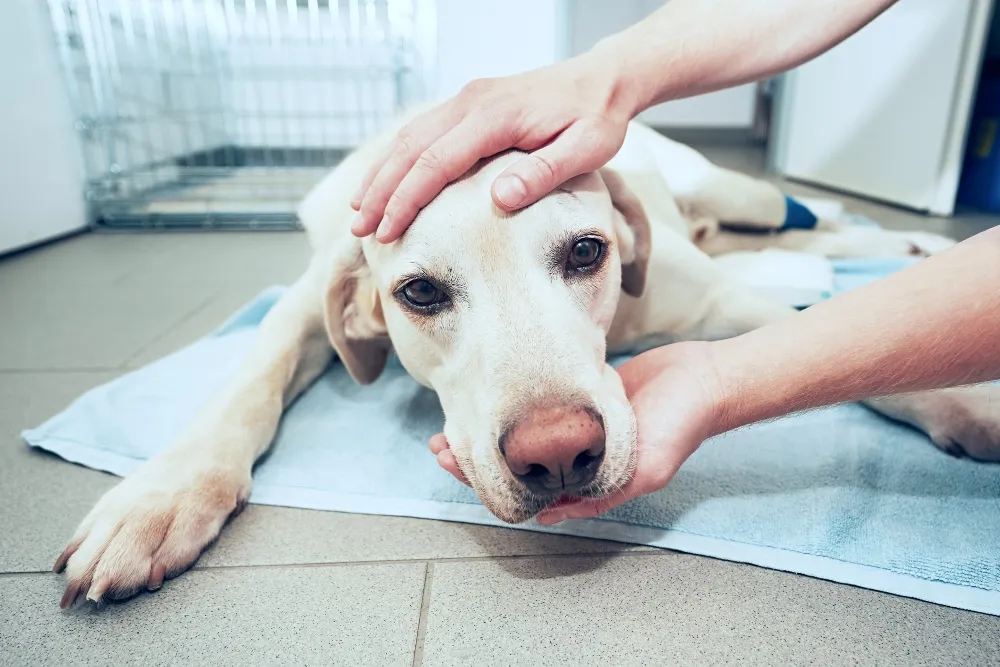Table of Contents
Many different types of shock can affect dogs, but what they all have in common is that they are true emergencies. If you think that your dog might be going into shock, immediately follow these step-by-step instructions:
What to Do if Your Dog is Experiencing Shock
- Get help from anyone who might be nearby. You can proceed by yourself if you have to, but having at least two people involved in a dog’s care is better.
- Call a vet immediately. If your regular veterinarian isn’t open or nearby, call a vet that you can get to quickly. They can talk you through helping your dog based on the specifics of the case. They will also want to prepare for your dog’s arrival at the clinic.
- Stop active bleeding by using a cloth to put pressure on wounds. Tourniquets should only be used as a last resort and kept as loose as possible.
- Follow the ABCs of CPR. Check your dog’s Airway and clear it if it is blocked. Check your dog’s Breathing and provide supplemental breaths if they’re not breathing. Check your dog’s Cardiac Function and perform chest compressions if you can’t feel a pulse or heartbeat.
- Make a stretcher by sliding a blanket, ironing board, sheet of plywood, or something similar under your dog. Do NOT move your dog more than necessary as this can worsen their condition.
- Cover your dog with a blanket, coat, or anything else to keep them warm.
- Get to the vet as quickly (and safely!) as possible. Keep your dog on the stretcher to minimize their movement.
The Different Types of Shock in Dogs
Shock can be brought about by any condition that reduces the ability of cells to use oxygen and produce energy to a degree that leads to tissue and organ damage. The types and causes of shock in dogs can be broken down into several categories.
Circulatory Shock
When a dog’s heart and circulatory system can’t adequately move blood around their body, their tissues become starved of oxygen, leading to shock. Circulatory shock is the most common type of shock in dogs and can be further divided into three types:
Hypovolemic Shock
Profuse bleeding, movement of a lot of fluid out of the circulatory system, or severe dehydration will drastically reduce the volume of blood in a dog’s body.
Cardiogenic Shock
Poor heart function (due to heart failure or arrhythmias, for example) will lead to a lack of oxygen delivery to cells and cardiogenic shock.
Distributive Shock
Anything that causes blood vessels to dilate excessively makes it hard for the heart to move blood throughout the body. Severe allergic reactions can lead to anaphylactic shock, and severe infections can result in septic shock, both of which are forms of distributive shock.
Hypoxic Shock
Disease or injury to the respiratory system can limit the ability of a dog’s lungs to transfer oxygen into the bloodstream. For example, dogs who are choking or have severe pneumonia may develop extremely low blood oxygen levels and go into hypoxic shock. Dogs also need enough healthy red blood cells to carry blood from the lungs to the rest of the body. Severe anemia or conditions that result in red blood cell abnormalities can also lead to hypoxic shock.
Metabolic Shock
Poisonings (cyanide, for example) or health problems like very low blood sugar levels can adversely affect the ability of cells to use oxygen and produce energy leading to metabolic shock.
It’s important to remember that dogs may suffer from multiple types of shock at the same time. For example, a dog with parvovirus might be severely dehydrated and have a bacterial infection in their bloodstream. They could develop both hypovolemic and septic (distributive) shock.
How to Recognize Shock in Dogs
Dogs with most types of shock have similar symptoms. However, all dogs won’t show every one of the following signs of shock, especially early on.
- Pale or even blue mucous membranes. They may be dark red in cases of distributive shock.
- Skin that is cool to the touch, especially around the ears, tail, and paws
- Confusion
- Weakness
- Rapid heartbeat and breathing rate
- Vomiting
- Shivering
As a dog’s condition worsens, their heartbeat and breathing rate can slow and they may slip into a coma.
How Do Veterinarians Treat Shock in Dogs?
It’s absolutely critical to get dogs who are showing signs of shock to a veterinarian as quickly as possible. The veterinarian will immediately try to stabilize the dog’s condition once they arrive. This typically involves:
- Giving the dog supplemental oxygen to improve oxygen delivery to cells
- Placing an intravenous (IV) catheter
- Rapidly giving the dog IV fluids to maintain their blood pressure.
- Medications can also be given to improve cardiovascular function.
Next, treatment starts to focus on the underlying cause of a dog’s shock and on any secondary problems that may develop. For example,
- Dogs with severe anemia or blood loss may need a blood transfusion.
- Dogs who are in septic shock often require intravenous antibiotics.
- Anaphylaxis can be treated with diphenhydramine, corticosteroids, epinephrine, and other medications based on a dog’s specific needs.
- Heart failure and arrhythmias may respond to medications or other types of interventions.
- Shock can lead to gastrointestinal ulcers that require treatment with medications to heal.
Dogs who are in shock or are recovering from being in shock need to be closely monitored because their condition can change quickly. Physical examinations, labwork, blood pressure monitoring, and electrocardiograms may need to be repeated frequently so problems can be identified and treated before they become severe.
Recovering from Shock
With rapid veterinary attention, dogs can recover from shock, but their long-term prognosis depends on how quickly it is treated and its underlying cause. If the underlying problem can be resolved or successfully managed, dogs can go on to enjoy long and happy lives. On the other hand, severe shock is often fatal, particularly if veterinary treatment is delayed.
The quicker you get to a veterinarian the better. Dogs can go from showing no signs of shock to being in big trouble very quickly. Don’t delay — it’s better to err on the side of caution than to always wonder what might have been.








